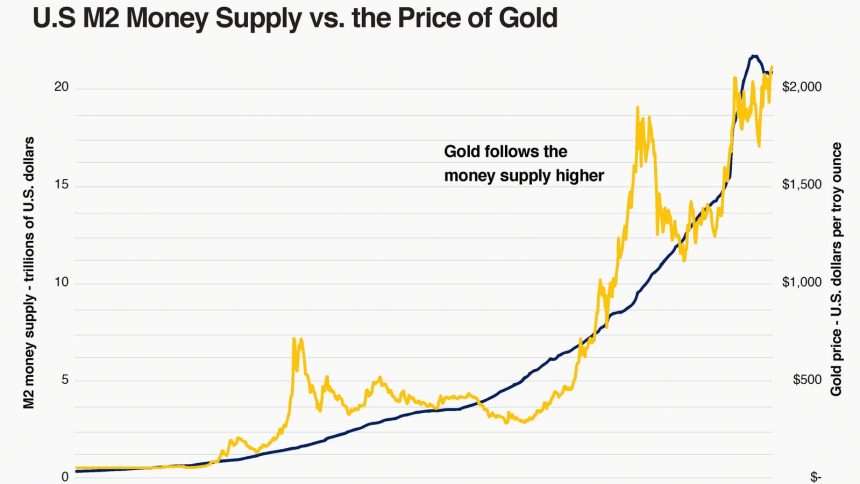From mid-2020 until very recently, gold traded in a directionless manner that frustrated and confused even the most fervent gold investors. Gold performed quite well during the 2020 COVID-19 pandemic thanks to the unbridled liquidity from central banks around the world, but it bounced around between $1,600 to $2,100 since then until it finally broke out of that trading range on March 4th. In this piece, I will discuss gold’s recent breakout as well as its long-term uptrend and several main factors that are driving it and should continue to drive it in the years ahead.
The Technical Picture
To get a better understanding of where gold has been and where it is likely going, it helps to take a step back and look at the big picture. If you look at gold’s chart for the past quarter century, you will see that gold is in a confirmed, long-term uptrend according to the most rudimentary principles of technical analysis. One of the key hallmarks of an uptrend is when an asset makes higher highs and higher lows over time, which is exactly what gold has been doing since the early-2000s. Furthermore, gold has been following a clear uptrend line for most of its two-decade-old bull market. According to the most basic principles of technical analysis, gold’s uptrend will remain intact as long as it stays above that uptrend line; a trend in motion tends to remain in motion.
Since mid-2020, there has been a strong resistance zone overhead from $2,000 to $2,100 that gold kept bumping its head on. On Monday, March 4th, gold finally closed above that resistance zone on very high trading volume, which gave a convincing bullish confirmation signal. As long as gold remains above the $2,000 to $2,100 zone (which is now a support zone), there is a high likelihood that another phase of the yellow metal’s long-term bull market has just begun.
How Paper Money Debasement Drives Gold’s Bull Market
There are a number of different drivers of gold’s long-term bull market, but one of the most obvious is the debasement or dilution of fiat or “paper” currencies. Since 1971, practically all of the world’s major currencies have been converted to inferior “paper” currencies that aren’t backed by gold, which led to the ballooning of the global money supply and sharp decreases of those currencies’ buying power via inflation or higher living costs.
Whenever the cost of groceries, energy, utilities, housing, automobiles, healthcare, and higher education rise at the same time, you can bet that the culprit is the debasement of paper money. In contrast, gold-backed currencies cannot be diluted the way that fiat currencies are diluted because every unit of currency must have a certain amount of gold backing it up and gold can’t be printed or created out of thin air. It’s easy to understand why people prefer to invest in gold when paper money is being diluted with no end in sight.
The jaw-dropping chart of the United States M2 money supply displays this principle very well. The M2 money supply is a measure of all notes and coins that are in circulation, checking accounts, travelers’ checks, savings deposits, time deposits under $100,000, and shares in retail money market mutual funds. The M2 money supply has more than quadrupled since the early-2000s, which has provided serious fuel for gold’s bull market that started at that time.
While paper money predictably loses value over time, this process took a sharp turn for the worse during and after the Global Financial Crisis & Great Recession as a result of unprecedented government bailouts, fiscal and monetary stimulus, zero interest rate policy (ZIRP), and quantitative easing (QE), which is basically a sophisticated form of money printing with the intention of pumping up the economy and financial markets.
The 2020 coronavirus pandemic led to an even more extreme episode of digital money printing that caused the global money supply to skyrocket as central banks around the world over injected countless trillions of dollars into their economies and financial markets to keep them afloat during the lockdowns.
The chart below shows the close relationship between gold and the money supply:
In theory, gold should follow the money supply fairly closely and it does. There are also times when gold outpaces or lags the money supply, which could be indicative of an upcoming correction or a bull run respectively. The chart below shows the ratio of gold’s price to the M2 money supply, which is an excellent way to see how gold is tracking money supply growth.
If the price of gold has greatly increased relative to money supply growth (as indicated by the red zone), there is a good chance of a correction ahead. On the contrary, if gold lags money supply growth (as indicated by the green zone), gold is likely to experience a rally to catch up to money supply growth. For the past decade, gold has slightly lagged M2 money supply growth, which means that gold is undervalued relative to money supply growth and may be poised for a period of strength with the help of the other price drivers discussed in this piece.
The U.S. Dollar’s Plunging Purchasing Power
As I’ve asserted throughout this piece, a rising money supply leads to inflation or the erosion of a currency’s purchasing power. The Noble Prize-winning economist Milton Friedman said it best with his famous quote, “Inflation is always and everywhere a monetary phenomenon…” Though short-term spikes in oil or food prices may generate the most attention, the steady erosion of purchasing power over time is a design flaw inherent to all fiat currencies. As you can see from the chart below, the U.S. dollar’s purchasing power has plunged by nearly 50% since the year 2000 thanks to the reckless policies and poor stewardship of the U.S. Federal Reserve.
Unfortunately, the sharp decline of the U.S. dollar’s purchasing power over the past quarter-century isn’t an anomaly but par for the course since the Federal Reserve was founded in 1913. Over the past 111 years, the dollar’s purchasing power has imploded by 97% and will continued to lose purchasing power over time as long as it remains a paper currency.
How the U.S. National Debt Comes Into Play
Another major driver of gold’s long-term bull market is America’s skyrocketing national debt. At the start of the 21st century, the United States’ national debt was a mere $5.77 trillion but has soared sixfold to $34.3 trillion as a result of the exorbitant wars in Afghanistan and Iraq, bailouts and stimulus programs during the Global Financial Crisis, and stimulus programs during the 2020 COVID-19 pandemic.
Sadly, there is no end in sight for America’s national debt binge. According to a recent U.S. Congressional Budget Office projection, federal debt held by the public as a percentage of GDP will rise from just under 100% to approximately 170% in the 2050s.
Over the past four years, the sharp increase of both the national debt and interest rates have caused annual interest payments to double to over $1 trillion:
Now that federal interest payments are a cool $1 trillion per year, they are expected to surpass both the cost of defense and Medicare for the first time:
Since 2020, U.S. federal interest payments as a percentage of GDP have increased at the sharpest rate since at least the 1950s:
When a country’s national debt burden sharply increases, so do the odds of a fiscal, economic, and currency crisis. Savvy investors, central banks, and other market participants are aware of those risks, which is why they have been bidding gold up since the early-2000s. The uncontrolled increase of America’s public and private debts are what will eventually be the death knell for the dollar as the Fed and U.S. government are forced to run the printing presses faster and harder than ever before in order to pay for the skyrocketing cost of interest, Medicare, Social Security, welfare benefits, additional bailouts and fiscal stimulus programs, and all other government spending. The U.S. dollar’s ultimate demise shouldn’t come as a shock as it will be the same fate experienced by all historic paper currencies.
Conclusion
In this piece, I showed how gold began a strong bull market in the early-2000s and that this bull market is still very much alive despite being two decades old. Not only is this bull market still alive, it just got reinvigorated by its impressive close above the $2,000 to $2,100 resistance zone that has acted as a ceiling for the yellow metal over the past several years. The original drivers of gold’s uptrend are still in play and are even worsening, in many cases.
In the coming years, debt and the money supply are likely going to increase in a spectacular manner, which will ultimately set the stage for very high rates of inflation and the death of the U.S. dollar and other paper currencies. Though this piece is U.S.-centric, nearly every country is in the same situation and has charts and data that look very similar to the ones shown here. While the U.S. and global money supply will continue to surge over the next decade and beyond, the supply of physical gold and silver bullion will remain fairly stable in contrast, which is likely to lead to much higher precious metals prices. Based on that logic, physical gold and silver are my favorite investments for the treacherous times ahead.
If you feel the way that I do about the serious risks that we face and precious metals, I welcome you to check out BullionStar’s wide selection of gold, silver, and platinum bullion products.
(Note: this article is for educational purposes only. Nothing in this article should be construed as investment advice or advise to buy, sell, or hold any security, commodity, or other asset. Do your own due diligence.)
Read the full article here
















